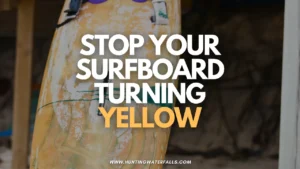Paddle boarding is a lot of fun but keeping your balance can definitely be tricky at times and learning how to fall and what to do once you've fallen off is extremely important.
You don't want to end up in the water with your board and paddle floating away from you or unable to get back up onto your board.
The two most important things to do when falling off your paddle board are to fall away from your paddle board (either to the side or behind the tail) and to fall flat into the water. Once you’re in the water, prioritize getting back to your paddle board before going after your paddle.
Make Sure Fall Away From Your Paddle Board
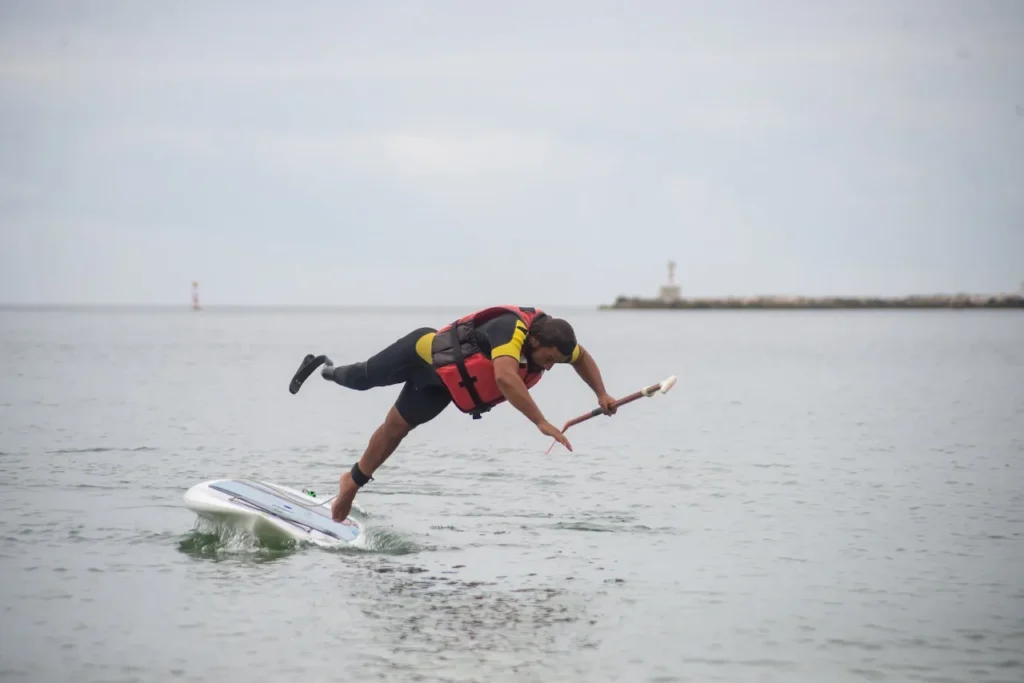
One of the common injuries for paddle board beginners is falling onto their board and hurting their hips, bum, back or lower legs.
Committing to the fall and forcing yourself away from the board into the water is generally much safer than falling onto your board and it's not so scary with practice.
If you start to feel yourself lose your balance it’s usually best to control the momentum while you still can and push yourself off one of the sides of your board.
Fall Flat Like A Pancake In Shallow Water
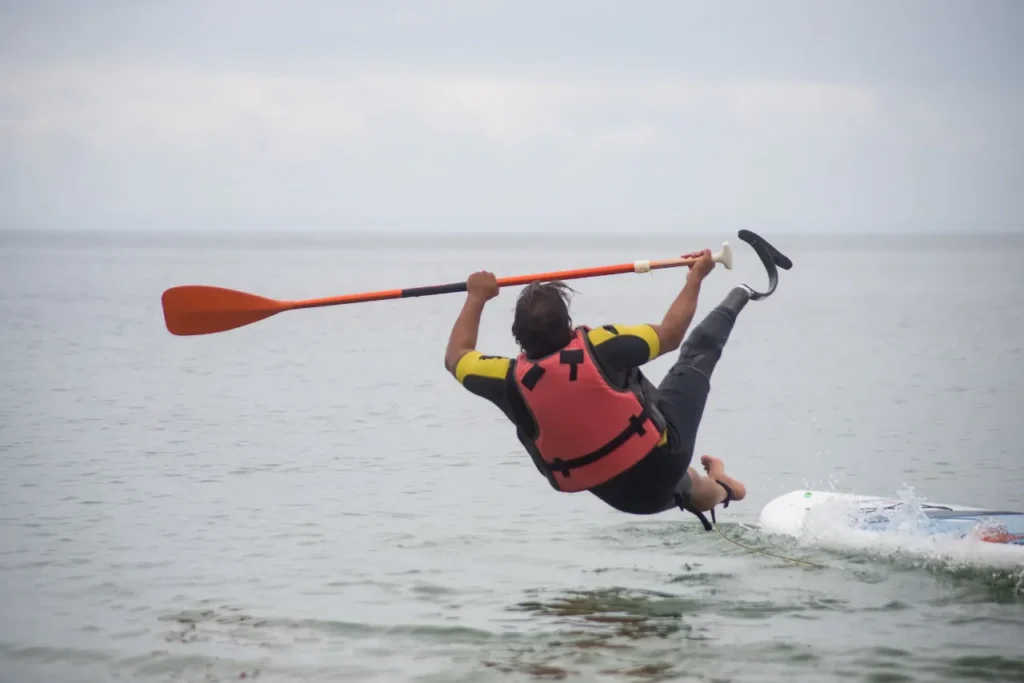
Since a lot of paddle boarding happens in calm and often shallow waters you'll want to fall flat to avoid hitting anything lurking below the surface.
Going feet first or diving in with your head puts you at risk of cutting your feet or concussions if there are rocks or the ground underneath shallow water.
Falling flat stops you going deep underwater. I personally like to fall bum first so I don't end up doing a belly flop or back slap in the water which can be painful.
Alternatively, I'll go feet first but once in the water I will spread out of body so I don't do a pin drop and go extremely deep.
In deeper waters where I know there is nothing underneath me I'll often do a feet first drop and occasionally I'll try to grab the board on my way down so it doesn't get too far away from me. However, you do need to be careful doing this as you can hurt your arms slapping the board quite hard on your way down or even up slapping your body against the board.
Only do this type of fall if you feel controlled, but generally it's best to just fall away from the board. You'll be attached by the leash so your board won't go far.
Once you get comfortable paddle boarding you probably won’t need a helmet for the same reasons surfers avoid them, but they could be useful for your first few outings or if you're paddle boarding in particularly dangerous circumstances..
Grab Your Board Before Your Paddle
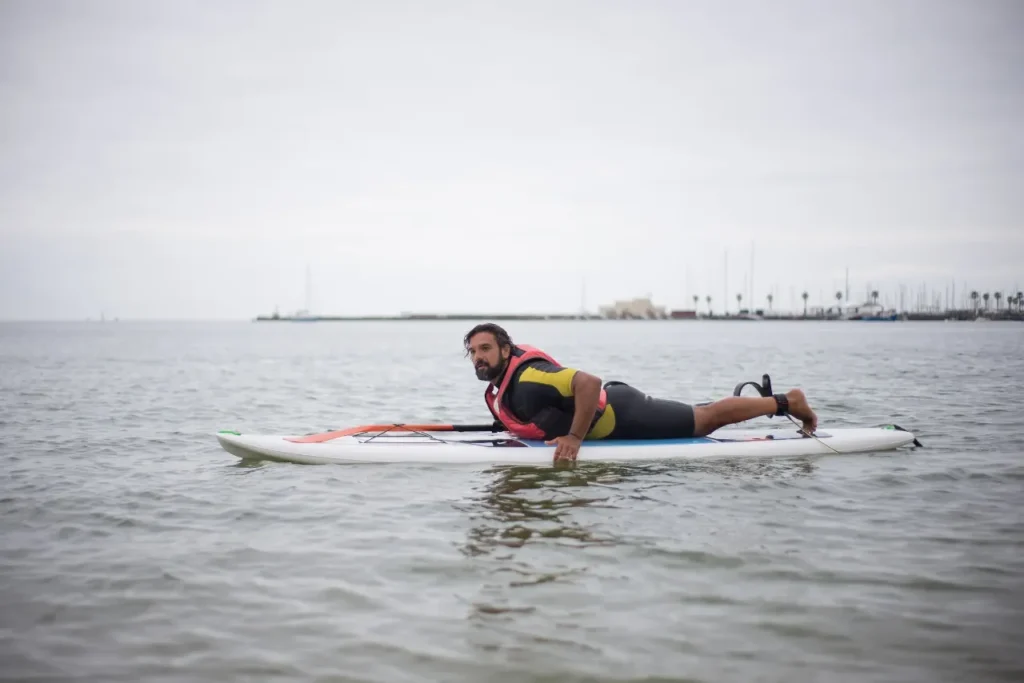
Once you’re in the water, prioritize getting back to your board rather than your paddle. Ideally, you want to hold onto your paddle while falling, but it’s not always possible and safe to do it.
Ultimately, unless you're wearing a life jacket, the paddle board is your main flotation device, and it's much easier to use it to get your paddle rather than vice-versa.
Swimming back to your board with paddle in hand can be difficult. However, if you're a strong swimmer and the paddle is close to you then you can grab it and either swim back to the board or use your leg rope to pull the board towards yourself.
Just make sure you grab it before it comes and whacks you in the face.
How Do You Get Back On Your Paddle Board?
If your board has a carry handle or straps then use one hand to grab onto the carry handle and the other to grab the far side of the board.
Relax and float on the water surface, then slide your chest onto the board while kicking your legs for some forward momentum.
Focus on staying low to the board and not pulling the board up and out of the water as that can cause you to flip the paddle board.
Once your chest is up and onto the board grab the far rail and use it and the center handle to swing your body around so your legs go onto the board.
You’ll probably laugh about an infinite loop of barrel rolls one day, but it’s no fun in the moment if you’re using the wrong technique.
Alternatively, if you're finding getting onto the paddle board from the side difficult then you can get back on the paddle board from the rear, much like how surfers get on their board.
Swim up to the back of the board and push down on the tail of the board so it slightly submerges in the water. Slide your chest onto the board as much as you can.
Then using the straps or by simply grabbing the sides of the board slowly slide your way up onto the board.
You can then get up on your knees and move yourself towards the center of the board before standing up completely. Don't try to stand up on the back of the board or you'll likely just fall off.
Other great tips for getting back on your board include:
- Moving to shallow water and jumping back on your board this way.
- Attach a looped rope to the center handle of your board to use as a stirrup to push yourself up onto the board with your legs if you lack the upper body strength needed to get back on.
What Not To Do When Getting Back On Your Board
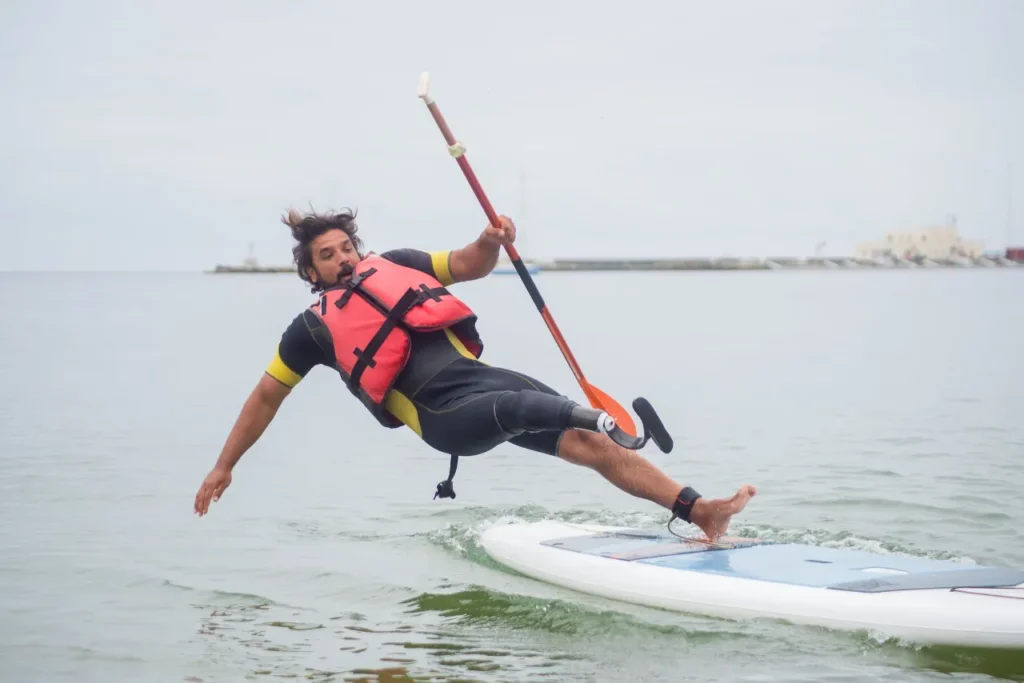
There are a few common mistakes people make when trying to get back on their board that make it more difficult.
Having Your Feet Under The Board
Having your feet under the board makes it difficult to get onto the board and makes it more likely that you'll roll the board completely.
You also can't use your legs to paddle. It can be a nice rest position in the water but once you're ready to get back on your board you'll want to have your feet behind you.
Bulky PFDs
While wearing a PFD/Life jacket can be a good idea, especially if you're not experienced the bulky PFDs can make it difficult to climb back up on your board.
If possible choose a slim lined PFD without any buckles or pockets to the front or choose an inflatable waist belt PDF as they are a lot less bulky and make it much easier to get back on your board.
Climbing Up Over Attachments
If your SUP has lots of side attachments or rings climbing up over these attachments can scrape you and be painful or you can get caught.
Find a clear area of your board without attachments that can scrape or stab you and pull yourself up in this spot.
Panicking or Rushing
Try not to panic or rush as this will cause you to fail around and will make getting up on the board harder.
Take a deep breath, take your time and you'll be back on your board in no time.
Not Asking For Help
If you're struggling to get up on your board and can't seem to manage it then don't be afraid to ask for help.
A friend or fellow paddle boarder can hold the opposite rail to stop the board flipping and make it more secure to climb up on or they could give you a push to get you back on the board.
For more advanced tips on getting back on your board check out the video below:
Learn To Fall The Easy Way
I’ve learned the hard way that learning to fall in a safe space is way less stressful than doing it on the open water.
Before you get too adventurous on your paddle board I’d recommend taking a few practice dives in a calm spot with other people around to perfect your technique for the real deal.
During your first few outings (especially in cold water), you might want to throw on a wetsuit since, unless you’re a budding Olympic athlete, you’ll probably hit the deck a couple of times like the rest of us.
As you get better at paddle boarding you can transition to something more comfortable and stylish like a rash vest.



